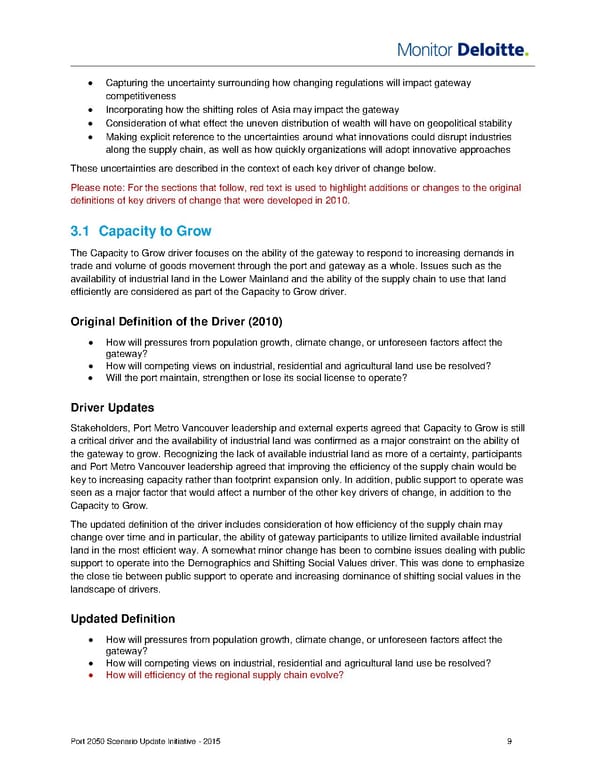• Capturing the uncertainty surrounding how changing regulations will impact gateway competitiveness • Incorporating how the shifting roles of Asia may impact the gateway • Consideration of what effect the uneven distribution of wealth will have on geopolitical stability • Making explicit reference to the uncertainties around what innovations could disrupt industries along the supply chain, as well as how quickly organizations will adopt innovative approaches These uncertainties are described in the context of each key driver of change below. Please note: For the sections that follow, red text is used to highlight additions or changes to the original definitions of key drivers of change that were developed in 2010. 3.1 Capacity to Grow The Capacity to Grow driver focuses on the ability of the gateway to respond to increasing demands in trade and volume of goods movement through the port and gateway as a whole. Issues such as the availability of industrial land in the Lower Mainland and the ability of the supply chain to use that land efficiently are considered as part of the Capacity to Grow driver. Original Definition of the Driver (2010) • How will pressures from population growth, climate change, or unforeseen factors affect the gateway? • How will competing views on industrial, residential and agricultural land use be resolved? • Will the port maintain, strengthen or lose its social license to operate? Driver Updates Stakeholders, Port Metro Vancouver leadership and external experts agreed that Capacity to Grow is still a critical driver and the availability of industrial land was confirmed as a major constraint on the ability of the gateway to grow. Recognizing the lack of available industrial land as more of a certainty, participants and Port Metro Vancouver leadership agreed that improving the efficiency of the supply chain would be key to increasing capacity rather than footprint expansion only. In addition, public support to operate was seen as a major factor that would affect a number of the other key drivers of change, in addition to the Capacity to Grow. The updated definition of the driver includes consideration of how efficiency of the supply chain may change over time and in particular, the ability of gateway participants to utilize limited available industrial land in the most efficient way. A somewhat minor change has been to combine issues dealing with public support to operate into the Demographics and Shifting Social Values driver. This was done to emphasize the close tie between public support to operate and increasing dominance of shifting social values in the landscape of drivers. Updated Definition • How will pressures from population growth, climate change, or unforeseen factors affect the gateway? • How will competing views on industrial, residential and agricultural land use be resolved? • How will efficiency of the regional supply chain evolve? Port 2050 Scenario Update Initiative - 2015 9
 Monitor Deloitte - Final Report Page 10 Page 12
Monitor Deloitte - Final Report Page 10 Page 12